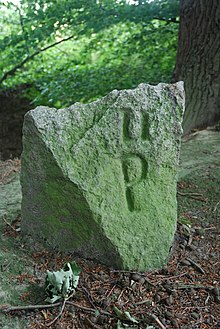Lübeck Landgraben
The ditch and some ramparts (especially the so-called Schwedenschanze in Lauerholz ) form the medieval Landwehr , with which Lübeck, like other cities in the Middle Ages, secured its urban area.
History and course
When the land ditch was built from 1303 - probably after an attack by the Ascanian Duke Otto in 1301 - the aim was to include as many natural bodies of water as possible in its course, the names of which were sometimes even lost as a water body designation over time. It was completed around 1350.
How this Landwehr works is not fully understood. In any case, because of its length, it could not be fully manned and the onslaught of enemies could only be stopped and not prevented. Probably the function lies in this and in the obvious marking of customs boundaries. Special safeguards are known on the main streets of Eutin am Tremser Teich , Segeberg am Steinrader Damm, Oldesloe am Moislinger Baum, Hamburg am Krummesser Baum, Ratzeburg and Mölln am Grönauer Baum and finally Wismar near Schlutup . There were even towers in Trems, Schlutup, Brandenbaum and on the Grönauer and Krummesser trees. For example, 1506 clashes with the Mecklenburgers at Schlutuper Turm or 1509 with the Danes at Tremser Turm are attested to them. The control posts were occupied by the Lübeck city military . As the last of the towers, the tower at the Grönauer Baum was demolished in 1809.
The Landgraben essentially runs through today's districts of St. Jürgen , St. Lorenz , Schlutup and St. Gertrud , from the Wakenitz with the Strecknitz over the Grönauer Baum to the Krummesser Baum, from there north to the Moislinger Baum and further east to Roggenhorst. Beyond the Bundesautobahn 1 , it leads north over the Steinrader Baum, then as the Fackenburger Landgraben to the Tremser pond . A footpath runs parallel in this area. In the north the Trave to Schlutup formed this border.
From Schlutup the Landgraben leads through the Schwarzmühlenteich to the so-called Schwedenschanzen with the course of the Hertogenbeke to the Wakenitz. The name Schwedenschanze has no historical background. In this area, the Landgraben also partially forms the border with Mecklenburg-Western Pomerania . It has two directions of flow, from about the Schwarzmühlenteich it flows both in the direction of Wakenitz to the south and through the Schlutuper Mühlenteich in the direction of the Trave to the north.
During the construction of the embankment of the Lübeck – Bad Kleinen railway line , a piece of the ditch had to be relocated, which also shifted the border between the Free and Hanseatic City of Lübeck and the Principality of Ratzeburg . The new course of the ditch and border was created by a border recession between Lübeck and Mecklenburg-Strelitz on 19/21. Codified January 1869.
As a cultural monument of particular city and state historical value , which has a formative value for the cultural landscape , the entire course was entered in 2015 in the list of monuments under the Monument Protection Act (Schleswig-Holstein) and thus placed under monument protection.
See also
literature
- Werner Neugebauer: The medieval Landwehr of the Hanseatic City of Lübeck . In: The car . 1969, ISSN 0933-484X , p. 74-78 .
- Peter Hartmann: Schwedenschanzen: Medieval Landwehr . In: Hanseatic City of Lübeck, Excursions on Archeology, History and Culture in Germany, Volume 56 . Theiss Verlag Darmstadt, 2013.
- Peter Hartmann: Landwehr protects Lübeck over a length of 40 kilometers . In: Lübeckische Blätter 2004, issue 4 . Verlag Schmidt- Römhild Lübeck, p. 49 ff .
- Peter Hartmann: The Lübeck Landwehr in the Middle Ages and the Early Modern Age, annual publication of the Archaeological Society of the Hanseatic City of Lübeck, special volume 1, Lübeck 2016 ISBN 978-3-7950-5236-2 .
Web links
- List of monuments of the Hanseatic City of Lübeck 2. Archaeological monuments; sorted by district (2015): No. 145, 147, 148, 149, 150, 155
- Overview map
Individual evidence
- ↑ This was the son of Duke Albrecht II of Saxony-Wittenberg , to whom the Emperor had granted the protective bailiwick over Lübeck.
- ^ Gottlieb Matthias Carl Masch: History of the Diocese of Ratzeburg . Asschenfeldt, Lübeck 1835, p. 130 ( google book search ).
- ^ Collection of the Lübeck ordinances and notices. 36 (1869), pp. 35-39
- ↑ The Landwehr of the Hanseatic City of Lübeck is now on the list of monuments , accessed on December 28, 2015



